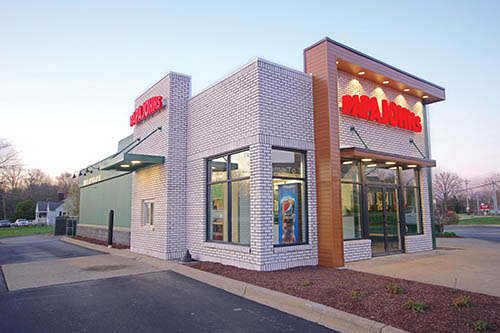— By Katie Lee —
Coming off a strong year of growth, pizza legend Papa Johns takes its ‘dough show’ on the road, both domestically and abroad, with a brand-new look.
The best, by definition, outshine the rest — but some years the best outshines even itself. 2023 was one of those years for Papa Johns. Founded four decades ago in Louisville, Kentucky, the pizza legend notched a great year in 2023, a year that finished as one of its best for new North America store openings in the past 5 years and 328 system-wide new openings in 2023. Papa Johns is positioned for continued growth with plans to accelerate North America development in 2024.
Papa Johns, which opened its second corporate hub in Atlanta in late 2021, attributes its 40-year success to strong execution by its corporate teams and franchisees. Further fueling the fire are enviable sales growth numbers that are driven by menu innovation, enhanced revenue management and sustained growth in the third-party aggregator channel. Preliminary global system-wide sales increased approximately 5% for fiscal year 2023, according to a January press release from the brand.

“All of this provides an attractive and unique opportunity for franchise candidates aiming to grow with our brand,” says Patrick Coelho, who joined Papa Johns in July 2023 as senior vice president of North America development.
Previously, Coelho was chief development officer and head of international at Scooter’s Coffee; prior to that he spent several years at Restaurant Brands International, most recently as head of development for Burger King, Americas, where he fostered a high-growth mentality and designed development programs. Coelho’s decision to join Papa Johns was driven by its strong leadership team, the strength of the brand, the quality of the food offerings and the potential for global expansion, including growth in the U.S. and Canada.
“Unlike some large brands that are constrained by saturated U.S. markets, Papa Johns has great opportunities available in prime territories across the country,” Coelho says. “We have markets that are underpenetrated across both the U.S. and Canada. This provides ample room for growth and creates an opportunity to expand our relationships with growth-oriented, multi-unit franchisees in the coming years.”
Development at Home and Abroad
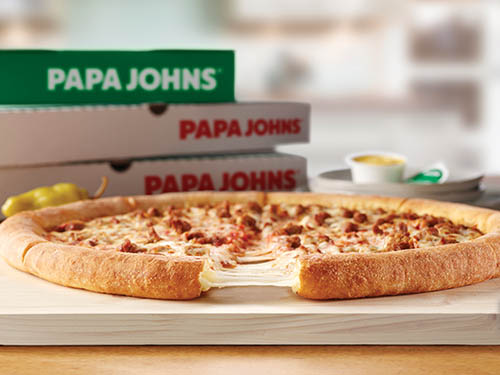
As for the current year, 2024, a key focus for both the brand and franchisees will be aligned toward further accelerating net restaurant growth, within the U.S. “The strength of the brand and current presence in the U.S. provides a solid thesis for the domestic growth strategy,” Coelho says. “Both Papa Johns and developing franchise partners are excited about accelerating U.S. growth. While international expansion remains a significant component of our long-range growth plan, we are focused on capitalizing on our strengths to grow Papa Johns presence in the U.S. market.”
Coelho further explains that the company’s approach to new store growth is grounded in developing strategic partnerships with franchisees. Papa Johns is committed to delivering attractive unit economics to franchisees while delivering superior products and excellent service to customers. This enables Papa Johns to capture share in a growing market. Moreover, the company recently announced in January a new incentive program that showcases the company’s commitment to accelerating domestic growth and providing opportunities for both existing and new franchisees. To pursue the significant untapped and underserved markets the company has identified in North America and accelerate development in 2024 and beyond, Papa Johns has designed a development incentive that aims to deliver higher restaurant-level EBITDA margins during the first 5 years of operations through a waiver of National Marketing Fund contributions. Currently, the Papa Johns system consists of approximately 530 U.S. restaurants that are company-owned (about 15% of its U.S. system), with the remaining ~2,900 restaurants being franchised. “Our foot is on the gas on franchise growth, but we are also accelerating corporate development, increasing our restaurant footprint in select markets across the U.S.,” Coelho says.
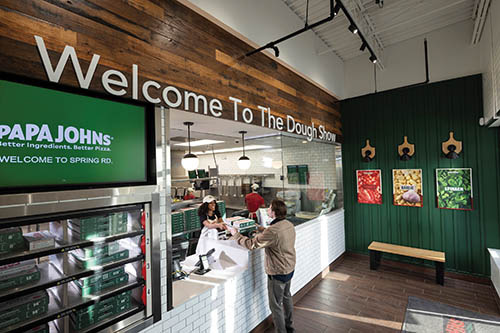
Growth is never just for growth’s sake, however. Another distinguishing factor in the Papa Johns growth strategy is its commitment to excellence. “Our teams are doing a great job at executing our Back to BETTER initiatives, and we see further opportunity to drive our strategic growth initiatives and further strengthen our model,” Coelho explains. “Growth serves as a pivotal element in this journey towards greatness.”
Furthermore, the company’s international presence adds another layer of distinction. The brand is sought after both domestically and internationally. As of 2023, Papa Johns had 2,475 international locations.
An Epic New Design
Papa Johns is growing with a brand-new look — one that showcases the warm colors of comfort food along with expanded operational efficiencies. Dubbed ‘Epic Dough,’ the new store design launched in late 2021 and uniquely conveys the flavorful ingredients of Papa Johns through a carefully curated color palette and textures throughout the space. The palette harmonizes the red of tomatoes, the green of basil showcased in the board-and-batten wall, and its signature garlic sauce depicted through imagery. The heart of the kitchen features the warmth of the oven, complemented by touches of warm wood elements, including pizza peel light fixtures.
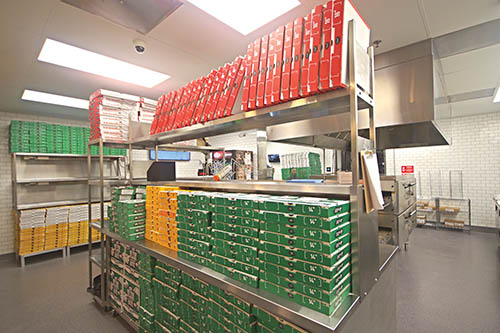
The operational efficiency of the Epic Dough model lies in its adaptability and size optimization. Floor plans are versatile, ranging from 900 to 1,500 square feet, allowing efficient use of space. Collaborating with operation teams, key equipment has been identified to maintain high volume while occupying less space. According to Coelho, such adaptability is crucial in a competitive real estate market, ensuring effective adjustments without compromising operational efficiency and throughput.
The store design includes an open kitchen where guests can witness the pizzas being individually handcrafted, enhancing transparency and connection with the cooking process. “The franchise community has positively received the design,” Coelho notes. “By leveraging the scale of our brand’s extensive restaurant network, we’ve collaborated with vendors to negotiate favorable pricing and ensure availability, thereby minimizing downtime during the buildout or remodel process.”
While the new look is attractive to guests who come inside to pick up their pizza, and to team members onsite, Papa Johns has always operated on a delivery model first and foremost. When the COVID-19 pandemic struck in 2020, the company was understandably more prepared than most to meet the new moment.
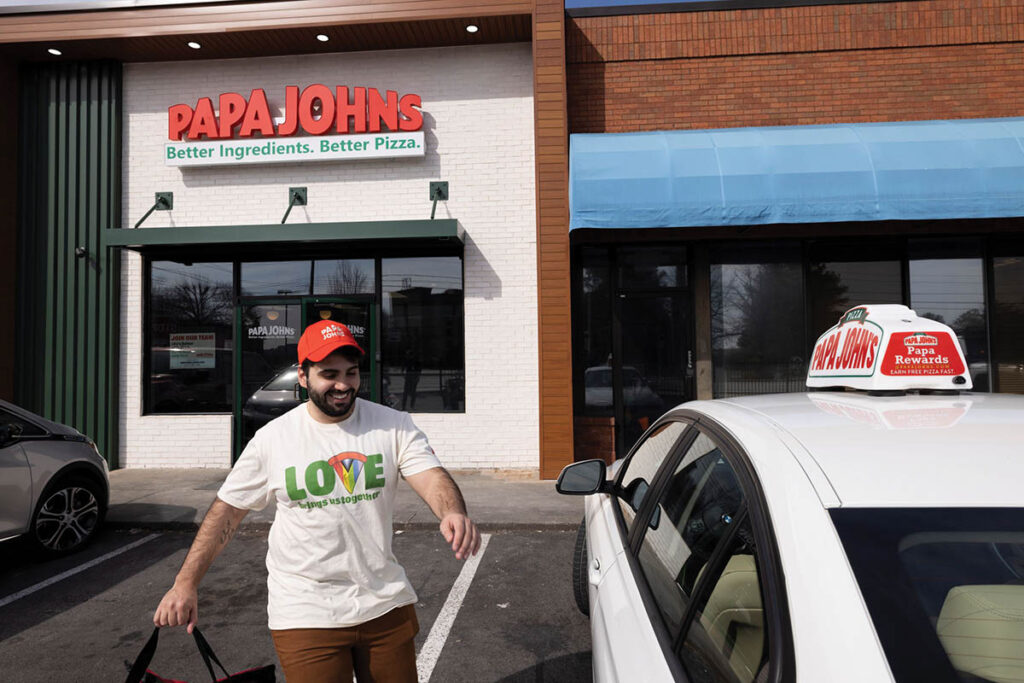
“Our robust delivery model has always been an attractive aspect for our guests,” Coelho says. “We have established comprehensive partnerships with aggregators, providing us with greater expertise, experience and capability in this channel.”
Increases to that aggregator capability will continue. “We feel good about the opportunity to continue growing in the aggregator channel as it remains a key driver of transaction growth,” Coelho says. “Complementing this growth is our core business where we will continue to innovate and deliver targeted promotions that offer our loyal customers more value and more compelling deals. Our goal is to be able to offer our rewards members attractive incentives to order through our organic channels. Entering 2024, we see even more opportunities to enhance our loyalty program to drive higher frequency and higher ticket through our organic channels.”
Technology Advancements
Papa Johns has been a leader in digital as technology has made it easier for it to engage and service its customers from any device. And it is not slowing down; Papa Johns continues to explore and expand its customer-facing technology.
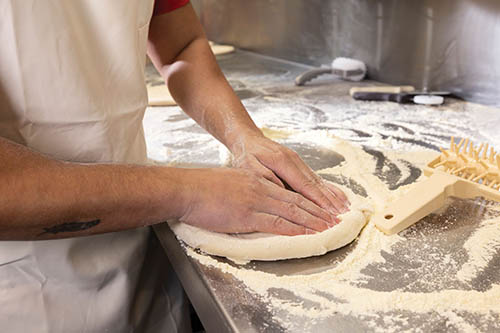
A new voice AI tool is currently being rolled out. Already in more than 30 restaurants, it has improved call time (from an average of 3-4 minutes down to 1-2 minutes) and increased customer satisfaction. The voice AI system is integrated into the Papa Johns management platform and recognizes if a customer has ordered before, allowing it to offer their usual favorites as well as new options they might enjoy.
Machine learning also helps Papa Johns fine-tune algorithms to correctly estimate how long before a pizza is delivered through the PapaTrack online ordering system.
When the pandemic hit, Papa Johns leaned into its delivery model even more — maintaining its delivery reliability with customers by integrating closely with others who are leading the evolution of delivery.
“We have a symbiotic relationship where our restaurant operators and franchisees can provide trips for the aggregator by turning to it when stores find themselves short on drivers,” Coelho explains. “Going forward, as these marketplaces bring on additional offerings attracting even more customers, we’re prepared for and excited about the broader opportunity presented to Papa Johns to continue to capture new demand.”
Post-pandemic, the accelerated adoption of technology to enhance the customer experience is one change that Coelho sees sticking around. “No matter where customers are or the platform they are using at a given time, we want to be right alongside them to make our brand as accessible as possible,” he says. “Our legacy of leadership in e-commerce and digital payments has us well-positioned to remain no more than a click, swipe or call away.”
Onward and Upward
What Coelho finds most fulfilling in his role at Papa Johns is the daily opportunity to impact the growth trajectory of the brand, help franchisees grow their businesses and progress a talented group of development professionals at the Papa Johns corporate offices.
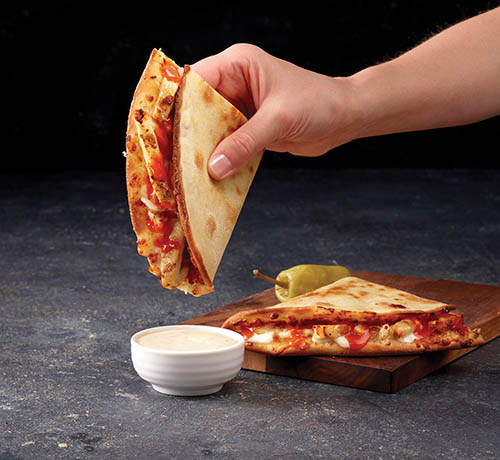
“Each day, we navigate the complexities of the industry, recognizing that successful development requires not only experience but also substantial resources to build a robust development infrastructure and pipeline,” he says. “It’s a demanding path, not suited for everyone. However, I take great satisfaction in partnering with franchisees who are up for the challenge, contributing to the growth and success of Papa Johns.”
In the short term, Papa Johns says its primary goal is to reengage existing franchise partners and attract new ones to accelerate growth in the U.S. Success in this arena will be contingent upon delivering attractive unit economics to franchisees, adapting floor plans to diverse spaces, and utilizing technology and menu innovation to elevate the customer experience.
In the long term, the overarching objective of Papa Johns is to sustain and build upon its current growth momentum. Its dedication to fostering a culture of excellence and adaptability positions Papa Johns as a sought-after global brand — and this philosophy also got the brand to where it is today. Founded in 1984, Papa Johns has built a storied history centered on delivering high-quality pizza and establishing an iconic brand with global presence. The company’s success lies in its commitment to excellence, creating a brand that resonates with customers and franchisees alike.
“By navigating challenges, embracing innovation and ensuring operational efficiency, we aim to secure a prominent and enduring position in the competitive pizza segment for the long term,” Coelho says.
— This article originally published as the cover story of the February 2024 issue of Retail & Restaurant Facility Business magazine. If you are interested in having your retail company profiled on an upcoming cover, please email the editor, Katie Lee, at [email protected].

